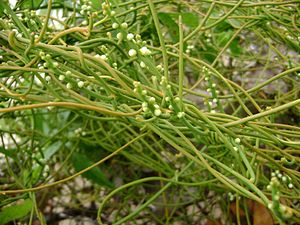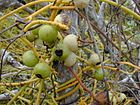Note: This is a project under development. The articles on this wiki are just being initiated and broadly incomplete. You can Help creating new pages.
Cassytha filiformis - Akashavalli
Akashavalliis leafless parasitic climbing twiner, that can be seen growing in South India in very dry gravelly localities.
Uses
Parts Used
Chemical Composition
The plant contains aporphine alkaloids.[2]
Common names
| Language | Common name |
|---|---|
| Kannada | ಆಕಾಶಬಳ್ಳಿ Akasha balli, ಅಮರ ಬಳ್ಳಿ Amaru balli |
| Hindi | Amarbeli, |
| Malayalam | Manjadiacatsjavalli, Aiyapala, Akashavalli |
| Tamil | Amaravalli, Ammaiyarkoonthal, |
| Telugu | Antharavallithige, Nooluthige. |
| Marathi | NA |
| Gujarathi | NA |
| Punjabi | NA |
| Kashmiri | NA |
| Sanskrit | Akashavalli, Amrtavalli, Khavalli |
| English | Love vine |
. [3]
Properties
Reference: Dravya - Substance, Rasa - Taste, Guna - Qualities, Veerya - Potency, Vipaka - Post-digesion effect, Karma - Pharmacological activity, Prabhava - Therepeutics.
Dravya
Rasa
Guna
Veerya
Vipaka
Karma
Prabhava
Habit
Identification
Leaf
| Kind | Shape | Feature |
|---|---|---|
Flower
| Type | Size | Color and composition | Stamen | More information |
|---|---|---|---|---|
| Bisexual | Spikes terminal or axillary; peduncle 2-4.5 cm. | {{{3}}} | {{{4}}} | {{{5}}} |
Fruit
| Type | Size | Mass | Appearance | Seeds | More information |
|---|---|---|---|---|---|
| A drupe | Drupe globose, enclosed within inflated perianth, crowned by lobes; seed 1. | {{{6}}} |
Other features
List of Ayurvedic medicine in which the herb is used
Where to get the saplings
Mode of Propagation
How to plant/cultivate
Seeds require scarification before sowing. [5]
Commonly seen growing in areas
Photo Gallery
References
External Links
Categories:
- Ayurvedic Herbs known to be helpful to treat Dysentery
- Ayurvedic Herbs known to be helpful to treat Skin diseases
- Ayurvedic Herbs known to be helpful to treat Hair problems
- Ayurvedic Herbs known to be helpful to treat Dairrhea
- Herbs with Stem used in medicine
- Herbs with common name in Kannada
- Herbs with common name in Hindi
- Herbs with common name in Malayalam
- Herbs with common name in Tamil
- Herbs with common name in Telugu
- Herbs with common name in Sanskrit
- Herbs with common name in English
- Habit - Climber
- Herbs that are commonly seen in the region of Tropical area
- Herbs
- Deccan
- Lauraceae




